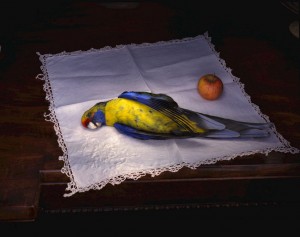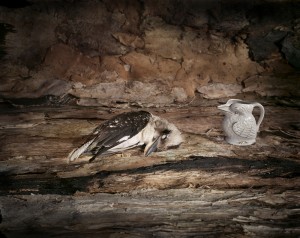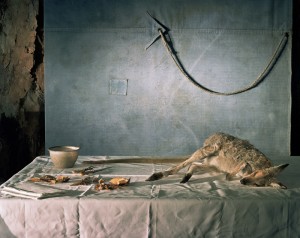Melbourne Art Fair 2006

Bandicoot with Quince, 2006
Digital image on German Etching Paper¸ Archival Pigments
112 x 143 cm

Wombat and Watermelon, 2006
Digital image on German Etching Paper¸ Archival Pigments
Crow with Salt, 2006
Digital image on German Etching Paper¸ Archival Pigments
112 x 134 cm

Magpie with Lime,s 2006
Digital image on German Etching Paper¸ Archival Pigments
112 x 134 cm

Pelican and Turnip, 2005
Digital image on German Etching Paper¸ Archival Pigments
112 x 135 cm

Swamp Hen with Candle, 2006
Digital image on German Etching Paper¸ Archival Pigments
112 x 134 cm

Fruitbat with Plate, 2006
Digital image on German Etching Paper¸ Archival Pigments
112 x 134 cm

Digital image on German Etching Paper¸ Archival Pigments

Marsupial with Protea, 2006
Digital image on German Etching Paper¸ Archival Pigments
112 x 134 cm

Tasmanian Rosella with Serviette, 2006
Digital image on German Etching Paper¸ Archival Pigments
112 x 134 cm

Rosella, 2006
Digital image on German Etching Paper¸ Archival Pigments
112 x 134 cm

Paddymelon with Flowers, 2006
Digital image on German Etching Paper¸ Archival Pigments
112 x 134 cm

Kookaburra with Jug, 2006
Digital image on German Etching Paper¸ Archival Pigments
112 x 134 cm

Wallaby and Tarpaulin, 2006
Digital image on German Etching Paper¸ Archival Pigments
112 x 134 cm
2 - 6 Aug 2006
This work is a re contextualization of Australian wildlife within the context of the European still life. It presents wildlife that becomes dislocated from the idealized view of animals in their natural habitat. The long lens of the ‘wild life photographer’ is replaced by the close up lens, painted light and the table top.
The historical framework of the European ‘food still life’, the familiar rituals of table preparation and the warm painterly caress of applied light lulls the viewer closer as they recognize a familiar mythology. This work aims to reveal a new relationship between our own urban and domestic lives and the cohabitating animal species. These animals are clearly ‘consumed’ or sacrificed within the context of our own progress and technological development.
In recent years study trips to Germany have provided a new framework in which to see the ‘roadkill’ animals of Australia. The European still life of the 17th and 18th century celebrated the ‘fruits’ of the land existing for ‘mans’ consumption.
These photographic prints present the animals as larger than life crisp digital images printed on German etching paper with archival pigments. The paper and light evoking associations of European painting and prints, but the photographic record, marks a specific event from contemporary ‘reality’.
These animals are familiar nationalist icons but within the context of our increasing domestic consumption they are a part of the attrition that result from a loss of habitat and dangerous environmental factors like roads and power lines.
This work hopes to draw attention to the value and beauty of these animals and acknowledge the relationship these animals have to our present lives.
